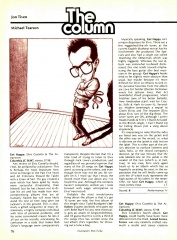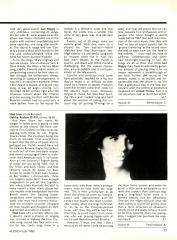—
|
Get Happy!!
Elvis Costello & The Attractions
Jon Tiven
|
Any review of Elvis Costello should, I feel, be prefaced by a disclaimer: This Is Perhaps the Most Important New Artist to Emerge in the Past Five Years and All Criticisms Should Be Taken with a Grain of Salt. The guy created a style which has been aped by many more successful (financially) than himself, but he has chosen not to dilute his art and has made four non-compromising albums that are all humanly flawed but will most likely stand the test of time long after Joe Jackson's in the ground. Elvis is obviously a gifted songwriter of many dimensions, a highly complex individual with tons of personal problems, and for some convoluted reason he lets it all out on his records, articulating his confusion in a code that makes Bob Dylan's language seem comparatively transparent. Despite the fact that I'm a little tired of trying to listen to Elvis through Nick Lowe's production, and regardless of my personal opinion that many of the 20 songs on Get Happy aren't as strong as the others, and even though there may not be any hit singles on it, I must say that I enjoy the record more than just about any I've heard this year. Although the contents haven't completely settled yet, I look forward with eager anticipation to Elvis' next record.
Probably the most revolutionary thing about the album is that it's got 10 tunes per side, the first album of this length since Todd Rundgren's Initiation (I guess anybody who goes out with Bebe Buell for any time eventually gets an attack of longwindedness), and I'd guess that this is only a third of the songs Elvis has written since the last album (he's legendary for throwing out a tune a day).
Musically speaking, Get Happy isn't a major departure for Elvis. There are a few reggaefied/ska-ish tunes, as the current English bluebeat revival has his involvement (he produced The Specials and also had a single out called "Watching the Detectives" which was highly reggaed). Whereas the last album was somewhat keyboard dominated, this one tends toward emphasizing the bass guitar (the best musician in the group). Get Happy's hooks tend to be slightly more obscure than usual, but maybe because it's more difficult for 20 or so refrains to sink in. My personal favorites from the album are "Love for Tender" (Declan McManus meets the Jackson Five), "Riot Act" (wonderful chord progression), "Motel Matches" (One of his better ballads), "New Amsterdam" (can't wait for Crosby, Stills & Nash to cover it), "Secondary Modern" (seemingly a sequel to "Green Shirt"), and "The Imposter" (Elvis about Elvis, sort of like "Big Boys"). The cover tunes are OK, although I prefer Heads Hands & Feet's "I Stand Accused" to the British single, "I Can't Stand Up for Falling Down" (not a song about impotence).
It's interesting to note that the sides are listed one way on the jacket and the other way on the record, i.e. what is side one on the jacket is side two on the label. This is either part of the artist's decision to confuse listeners and radio folks, or the record company's decision (at the last minute) that the side labeled one on the jacket is the weaker of the two (which is, in fact, true). In any case, Elvis once again treats us to an album which has us hopefully awaiting his next, in the expectation that he will finally come up with the LP which truly represents the high points of his talent. In the meantime, we have Get Happy, which almost comes close.
|
Sound: B-
Performance: A-
|


Illustration by Rick Tulka.
Get Happy!!
Elvis Costello & The Attractions
Michael Tearson
|
Elvis Costello's fourth album, Get Happy, could hardly have been more different from the third, Armed Forces. Forces was very carefully crafted, very much a studio and stereo creation with very good sound. Get Happy is very ambitious, containing 20 songs, ten per side. By aural appearances the album was mostly recorded live in the studio with minimal overdubbing and done rapid-fire, one song after another. The sound is tough and raw. Costello's voice is most often buried in the mix and undecipherable while the band has never sounded muddier.
As for the songs, 18 are originals and two are covers, one an obscure Sam & Dave B-side, the other a Mersey Beats song. Oddly, Costello seems intent on undermining some of his best ideas either through the deliberately cheesy recording or opaque arrangements. "B Movies" is an excellent example. When I first heard it played as a brand new song, it was an angry, driving, full-throttled rocker written right after the infamous remark about Ray Charles and the ensuing incident with Bonnie Bramlett — which had occurred only a week before. Now on the record the melody is a different, cuter one that forces the words into a jumble. The voice of fury gives way to a petulant whine.
Frankly, out of 20 songs, some are awfully good. With that many so it should be. Two ballads — "Motel Matches" and "Riot Act" — stand out. "High Fidelity" is a wonderful song with an insistent catch line in "Can you hear me?" "Beaten to the Punch" is spunky, and "Black and White World" is challenging. But the overall impression, an unavoidable one, is confusion amidst all the '60s sounds.
Costello and producer Nick Lowe have admirably reached for a lot, but they've made it as difficult as they could for a listener to absorb. Producer Lowe has written some brief notes for the album's back cover, obviously tongue in cheek, but they bear quoting: "Elvis and I talked long and hard about the wisdom of taking this unusual step [of putting 10 songs on a side], and [we] are proud that we can now reassure hi-fi enthusiasts and/or people who never bought a record made before 1967 that with the inclusion of this extra music time they will find no loss of sound quality due to 'groove cramming' as the record nears the end of each face (i.e. the hole in the middle)." I must read this note as sardonic, contemptuous and damn near downright insulting. In fact, the songs are all so short that while Get Happy does have an admittedly generous amount of playing time, it by no means represents a breakthrough of any kind. Further, the sound, as I've already noted, is so muddy and impenetrable that the album is no less than a gratuitous slap in the face, particularly after the technical excellence displayed on Armed Forces. And it is not anywhere near as much fun either.
|
Sound: D
Performance: C-
|

Cover.
|